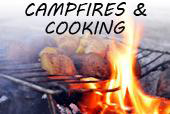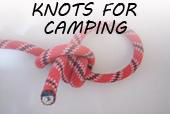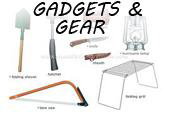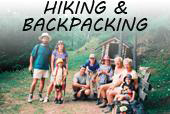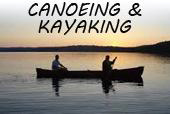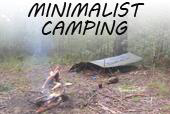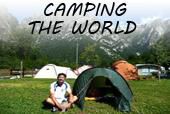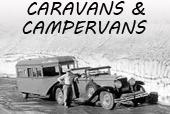Ironic isn’t it? Being a keen but less-than-successful prospector I find that, most often, success is directly related to the length of time I’m able to stay put, be it on a claim or out in the bush. But staying put depends on my economic resources in the first place!
Let’s be honest. As enjoyable as it might be, whether you’re fossicking or working a claim, unless you get lucky, long stretches away from the comforts of suburbia can become a real strain both physically and financially.
For most of us there’s not a whole lot we can do about that in the short term, but there are a few secrets to stretching those limited dollars to maximise our time pursuing whatever it is we like doing best. In fact, the real key to extended bush camping is to become as self-sufficient as possible. No, that doesn’t mean megabucks outlay on a tri-axle caravan complete with solar powered dishwasher. It means a bit of planning and practice to build up your skills in independent living.
In essence, true self-reliance is based on a realistic assessment of the sorts of resources we really need in order to maintain any given lifestyle. Obviously then, it’s also true to say that levels of comfort and convenience that each of us wants are based more on attitude than on some perceived physical necessity. And that comes down to personal choice.
But personal preferences aside, any consideration of lifestyle essentials must include — at least at the outset — those age-old requirements for staying alive: SHELTER, FOOD, WATER, FIRE and PROTECTION. Sure, our relative emphasis on each varies with circumstances and geography, but over time, all are necessary to some degree.
Shelter
The first rule: The longer you plan to stay in the bush, the more substantial your shelter ought to be. You also have to consider the flipside to this rule that says: The more frequently you change camp, the simpler should be your pack-up and set-up routines.
So, for true independence, along with a high degree of comfort and mobility, I find it hard to beat a compact motorhome or caravan — ideally a hardtop — for my home away from home. Agreed, conflict can arise between comfort and mobility in that, as RV size increases (ie, more comfort and convenience) manoeuvrability and mobility decrease accordingly. Therefore, in the interests of compromise, an RV with around 14-18 feet of living space, plus a quality awning, provides a good all-round shelter for living in the backblocks.
Although not essential, four-wheel drive traction adds significantly to mobility, particularly in gaining access to remote regions and tricky campsites. Almost certainly, fuel usage will be higher than for conventional vehicles, but the increased potential for “getting further out”, plus a higher margin of safety, make the extra cost worthwhile.
To gain an even greater level of independence and accessibility, I would also recommend increasing RV ground clearance (if practical), carrying an extra LPG/propane cylinder, and adding a 45-80 watt solar panel to trickle charge a couple of deep-cycle batteries to power 12 volt lighting and small appliances.
On the other hand, built-in showers are not always ideal for remote living scenarios because of their heavy usage of water, propane and 12 volt power.
Undoubtedly there are other accommodation options that can do the job — such as campervans, tent-trailers, even ordinary tents — but, all things considered, caravans and motorhomes are more comfortable, convenient and weatherproof than most other forms of outback shelter. Yes, initial outlay is higher, but need not exceed $10,000 – $15,000. For that sort of money, you’ll find a good selection of older model RVs that are pretty much bush-ready. And with minimum maintenance, they provide years of faithful service.
Food
Assuming you have neither the skill nor the inclination to catch and kill your own victuals, the amount of food carried into your camp obviously depends on the period of time until your next resupply. This timeframe also dictates your mix of perishable and non-perishable groceries, and your methods of storage and refrigeration.
For perishables, the best solution is to keep the RV fridge operating at a reasonable (though perhaps not ideal) temperature, thus stretching propane supplies to the maximum. This strategy can be prolonged with campfire cooking (to ration LPG even further). If climate permits, you might also think about adjusting the fridge thermostat to a less cold setting during the night.
Other possibilities are solar powered (12 volt) refrigeration (which, although initially expensive, is the ideal), or a small petrol generator. However, this latter solution, though effective, often raises the additional problem of fuel supplies.
Cooling expedients like evaporation cabinets and mountain streams may help, but shouldn’t be relied upon for the more finicky fresh foods, like meat, milk or butter.
Overall, the best bet is to minimise refrigeration requirements to start with by sticking to canned or dried foods as much as possible. These days, that still allows a huge choice of good-to-excellent low-budget meals.
Water
When you think about it, since the human body is around 65 percent water, it comes as no surprise that we need frequent intake of the stuff. Even when our activity is low and the climate cool, minimum consumption to maintain fluid balance should be a litre a day. Throw in some long hours of hard-rock excavation in mid-summer heat and, not surprisingly, that figure jumps to maybe five or six litres. And that still doesn’t allow for washing dust and grime from clothes and body, or keeping the kitchen tackle clean!
If there’s no reliable water supply close to camp, you will, of course, need to haul it in from someplace else. One of the easiest ways to supplement RV tank holdings is to bring along several 20 litre plastic containers. Allow eight litres per person for each day in the bush and with care, you should come out about right.
On the other hand, if nearby water is available, you should plan for collecting, filtering and sterilising when you draw up your equipment list.
Filtering, if necessary, can be through close-knit fabric such as pantyhose or untreated canvas, or alternatively, pass it through a 10 cm layer of fine sand. Also, allowing muddy water to stand overnight might be necessary to allow solid material to settle out.
The most reliable (and cheapest) method of sterilisation is to boil filtered water vigorously for at least three minutes. Sure, purifiers like Puritabs and Micropur work fine, but why spend your hard won cash when the boiling process is virtually free.
Campfire
It could reasonably be argued that a campfire — where permitted — is not really essential to keeping oneself alive. True, perhaps, but when you consider all that a fire can do for you, along with its considerable potential for saving a few bucks, the humble campfire becomes a real asset to the long-term camper.
Think about it: fire provides hot water, cooking, heating, rubbish disposal, clothes drying, insect control, light, water purification, comfort, and in dire circumstances, emergency signalling. All for a few cents a day!
Apart from a bushsaw, axe and perhaps a chainsaw, not much is needed by way of extra equipment.
Protection
Unless you’ve been totally isolated from the rest of the world for a good while, you’ll be painfully aware that violent crime is not on the decrease. Even in the remote wilderness, man’s inhumanity to the rest of us rears its ugly spectre from time to time.
OK, we don’t need to get paranoid here, but reasonable levels of caution and security are rarely out of place these days.
If, for example, you’re a fossicker onto good colour, keep it to yourself. Don’t encourage strangers around your camp, but remain as friendly and helpful as circumstances dictate. Keep your gear as secure as you can and don’t leave your camp unattended on a regular basis.
Without doubt, the best all-round protection and private security service is a dog. And they’re good company besides.
Another aspect of protection that you ought to consider is personal health and safety. Be aware of the many risks and dangers inherent in active, outdoor lifestyles and protect yourself accordingly. Infections, sunburn, and contaminated water are just a few of the common hazards we might encounter.
Keep in mind that sickness, injury and venomous bites can cost, not only in a financial sense, but may also necessitate a return to suburbia earlier than planned. A double whammy, if you will!
So…there you have my essentials of self-reliance for a long-term bush camp. Of course you may want to include a few luxuries for comfort or convenience — perhaps after a hard day of digging at the earth. In that case, the choice is endless!
Although having said that, there are one or two items top of the list for long-term stays. Like a bush toilet, camp shower, stereo radio/CD player, and maybe even an inverter (say 200 watts) to power odds and ends like an electric fan, TV/DVD, or additional lighting.
Self-reliance is more than spending up big on technology. It’s both a mind-set and a challenge. Indeed, remaining independent but comfortable on a shoestring budget, for lengthy periods, is both satisfying and rewarding.
Almost as rewarding as the wealth you might find in that next shovel-load of earth!

